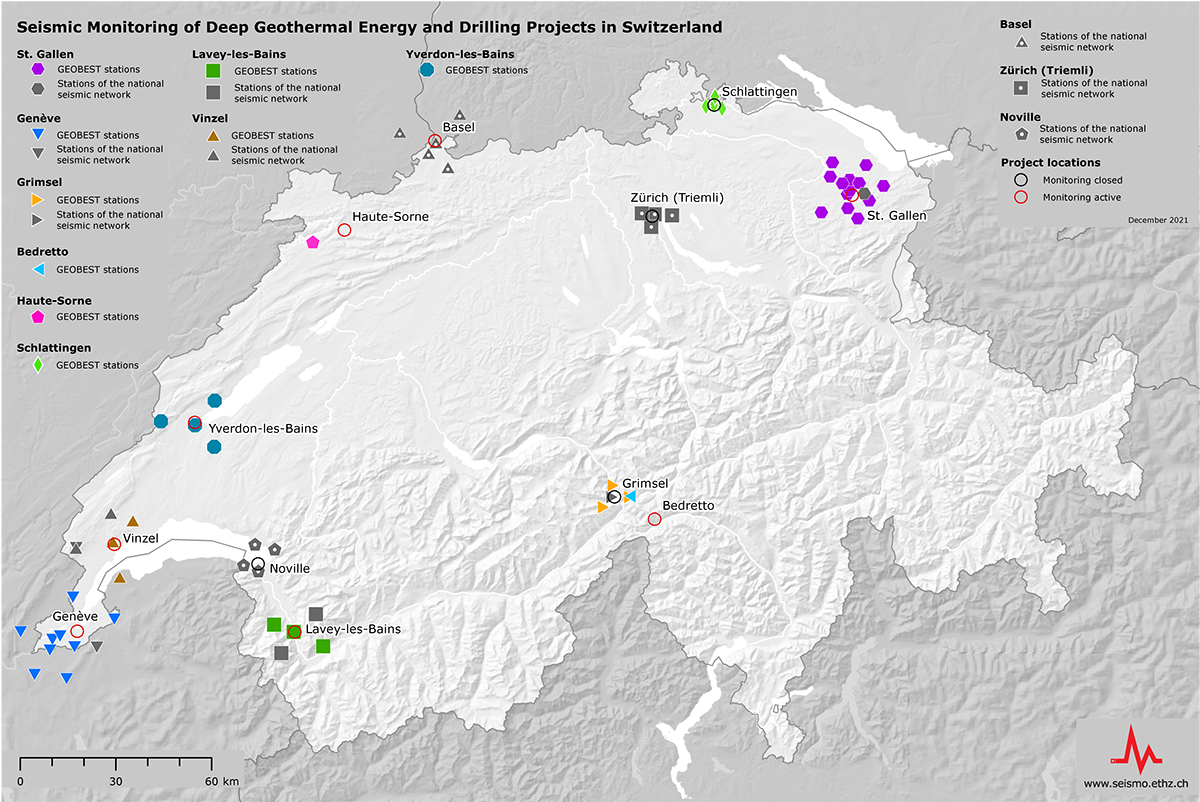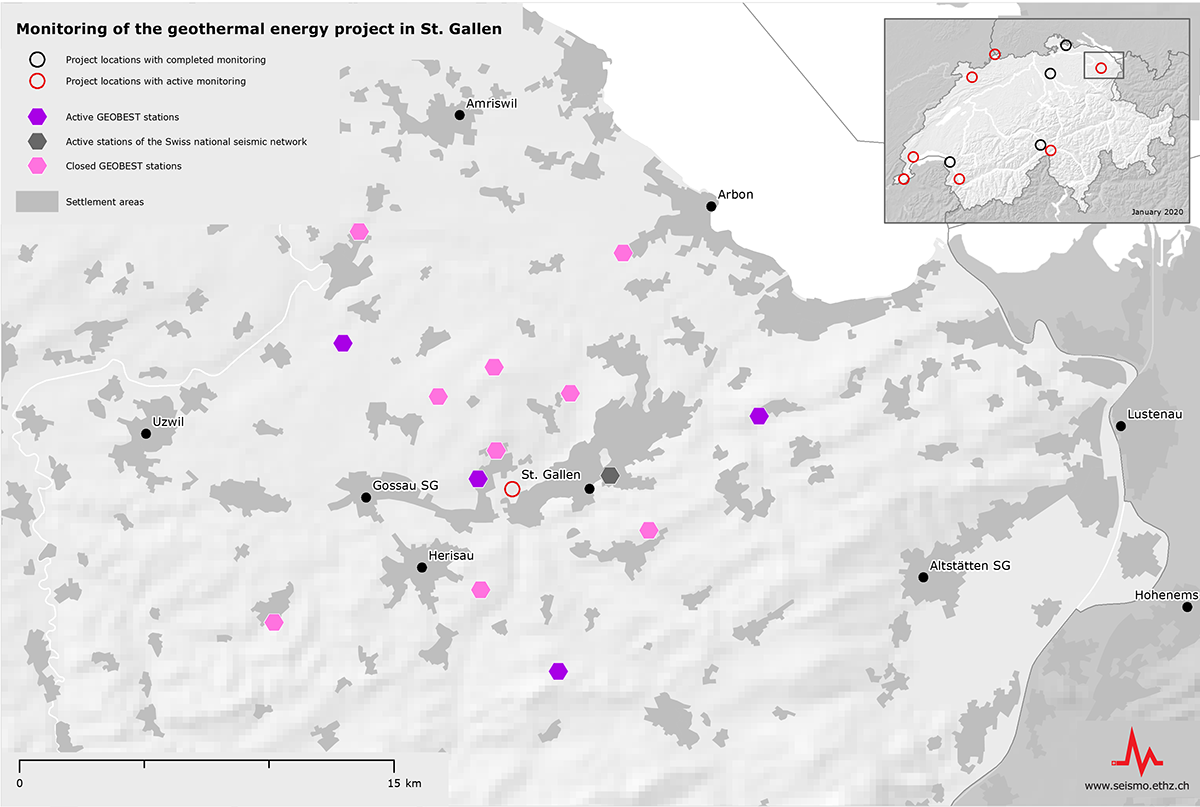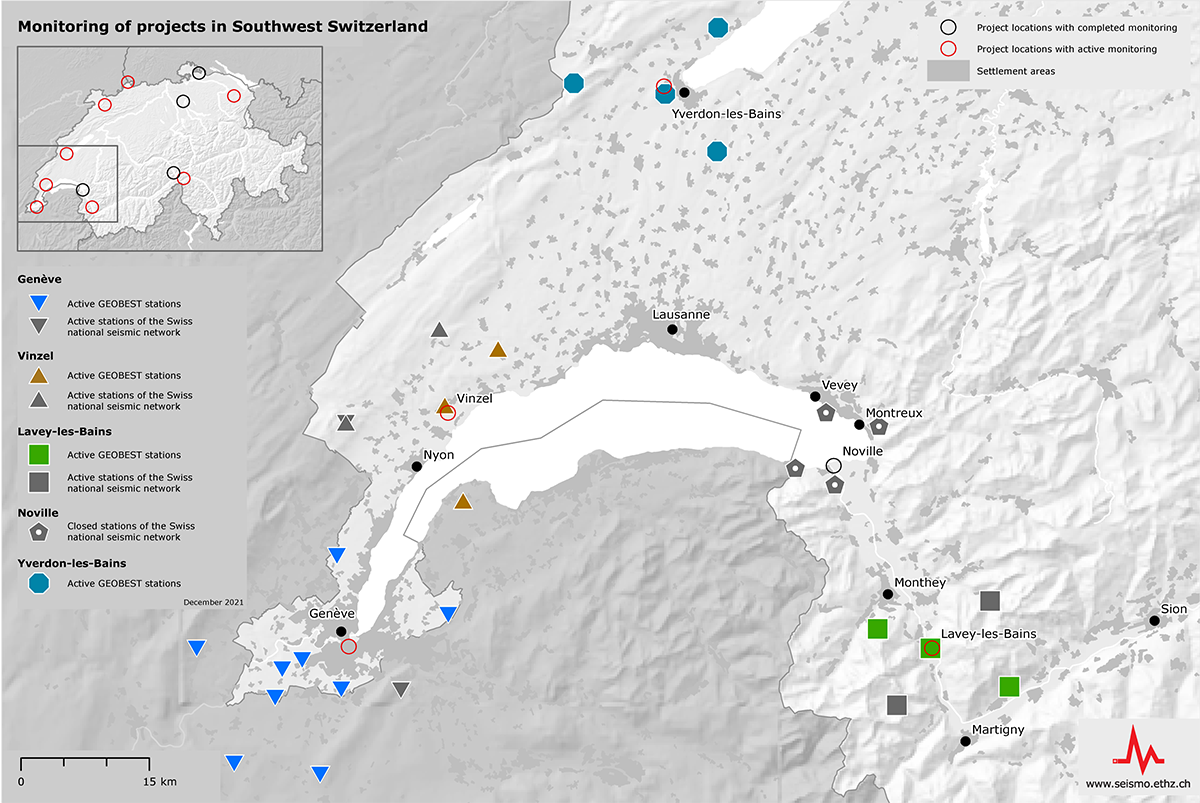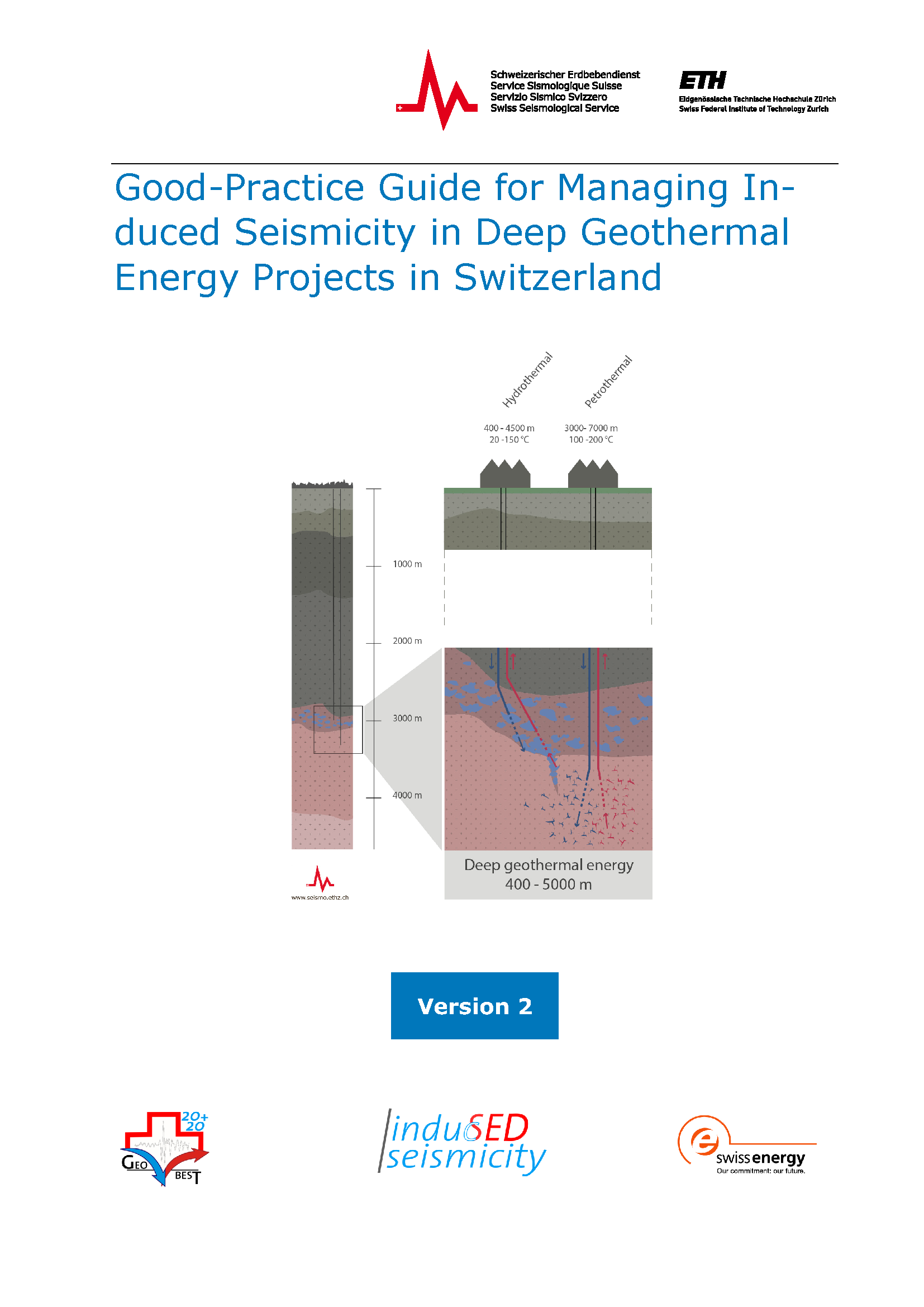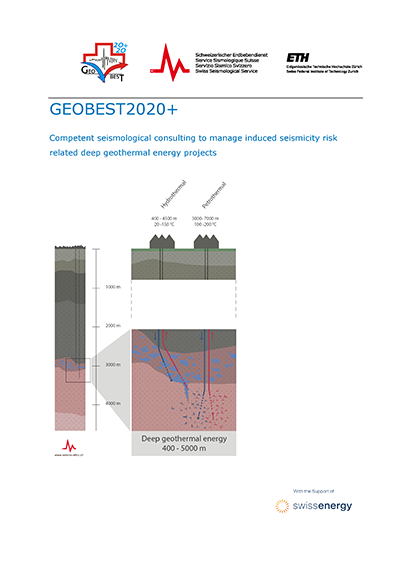GEOBEST2020+
A framework for cantonal authorities to handle induced seismicity risk in deep geothermal energy projects
As a local, versatile, clean, and renewable energy source, geothermal energy can contribute to achieving Switzerland’s energy and climate objectives. Switzerland is already one of the world leaders in ground-source heat-pump systems, typically referred to as shallow geothermal systems. However, also deeper geothermal resources exist in Switzerland that can be directly used for heat and power production. We will exclusively refer to geothermal projects that aim to exploit the latter resource in the following because only here, the potential risk of induced seismicity needs to be considered.
Worldwide, numerous geothermal projects have been successfully operating for decades. An example is the Riehen (BS) project, which has been providing heat into the local district heating system since 1994. Unfortunately, some geothermal projects have also been aborted during the reservoir construction or operation phase. The experience of the Swiss projects in Basel (2006) and St. Gallen (2012), but also recent international ones in Pohang (2017) or Strasbourg (2019), shows that severe project setbacks are often caused by the occurrence of unacceptable induced earthquakes. Therefore, adequate risk governance of induced seismicity is today seen as essential for establishing safe and economically viable geothermal projects. In Switzerland, the subsurface is under the sovereignty of the cantons. Therefore, it is essential that the cantonal authorities in charge of the permitting, concessioning and regulatory oversight of geothermal projects have access to independent, state-of-the-art seismological expertise. It is equally important that decisions and mitigation actions are based on reliable seismic data collected by an adequate seismic monitoring and analysis system. Independently conducted seismic monitoring and competent project oversight are important contributions to risk governance and can help build and maintain public acceptance of geothermal projects.
What GEOBEST2020+ can do for the cantons
GEOBEST2020+ is first of all an offer of support for cantonal agencies with respect to managing induced seismicity risk related to geothermal projects. On request by cantons, the SED can take up certain roles, as described below, generally without costs to the cantons.
Within the GEOBEST2020+ framework, SED experts can provide support to the cantonal authorities from the permitting phase, through concessioning, to the regulatory oversight of geothermal projects. This includes support with:
Defining induced-seismicity-related content requirements for all relevant cantonal authorisations that are mandatory for geothermal projects
The cantons define the content requirements for permitting and concessioning applications by the operators. The SED can help authorities to implement induced-seismicity-related aspects into all relevant cantonal procedures. The SED will coordinate with the canton in developing a canton-specific (or project specific) GEOBEST2020+ workflow for defining tasks of each involved stakeholder (i.e., operator, canton, and SED) and the interactions between them.
Participating in the GRID evaluation of projects
The SED has developed an easy-to-use pre-screening tool, called GRID, to classify the expected seismic risk associated with a geothermal project. GRID uses geological, technical and social information that are readily available before a project starts. The resulting GRID categories come with specific recommendations for seismic monitoring and the needed level of risk assessment and governance for each project. A GRID evaluation should be performed by three independent parties (e.g., canton, operator, and SED) and its results discussed in a joint meeting. The canton can then formulate specific requirements for the permit, based on an objective project classification.
Reviewing seismological aspects of permit and concession requests submitted by the project operators
On request of the canton, the SED can review seismological aspects of all documents submitted to the canton in relation to the planned or ongoing operations of geothermal projects (e.g., environmental impact assessment, drilling and testing concepts, regular status reports, and others). The SED will then evaluate the documents and provide recommendations for additional investigations, if needed.
Participating in project-accompanying advisory expert groups
An advisory expert group can accompany the geothermal project through all phases of its existence and advise the canton in critical project phases. This group should be composed of experts from the canton, operator, and SED and may include external technical experts. If the canton decides to form such a group, SED experts can participate.
Providing independent, canton-specific information on geothermal energy and seismicity to the public
GEOBEST2020+ enables the SED to provide independent background information on geothermal energy and induced seismicity to the public. The SED is doing this via dedicated pages on these topics on the SED website, public presentations and publications, or media interviews. This information can be augmented by up-to-date canton and project-specific information on the SED web site for cantons that decide to cooperate with the SED in GEOBEST2020+.
Coordinating public communication on project-related seismic events with the canton
The federal mandate of the SED includes informing the Swiss authorities and population on felt earthquakes in Switzerland. In such cases, the SED is mandated to publish earthquake information quickly and often respond to numerous media requests. For induced earthquakes in GEOBEST2020+ partner cantons, the SED can ensure that the cantonal authorities are informed about the occurrence of the event in near real-time (24/7). In this way, the SED can make sure that the canton knows that and what the SED must immediately communicate about the event. On the other hand, the SED can then make sure to refer media requests for project-specific questions to the right communication unit of the canton.
In GEOBEST2020+ the SED can provide and – on a canton’s request – take over the responsibility for adequate safety-related seismic monitoring, analysis, and earthquake alerting systems for geothermal projects. Specifically, the SED can support the cantonal authorities by:
Installing a customized seismological monitoring network for baseline monitoring
The network will ensure that all earthquakes with magnitudes ML>=1.0 are automatically detected and located with a location precision of 500 m or less within a perimeter of 5 km radius around the project sites. It will make use of existing SED stations where possible. Seismic waveform data will be stored on redundant servers at the SED and open data access provided via the SED’s FDSN web services.
Performing manual reviews of the seismological data
This analysis is done by a group of experienced seismologists as part of the daily routine analysis of the seismicity in Switzerland. This analysis also ensures that false automatic detections (i.e., quarry blasts or thunder) are identified and excluded from alarming procedures.
Sending earthquake alarms via SMS and email to the stakeholders defined by the canton
- Provide automatic location alarm for ML>=1.5 within 60s of occurrence.
- Update alarm with manual location within less than one hour of occurrence.
- Manual location alarm for all detected earthquakes within less than 1 working day.
- Reduced response times for manual review during critical project phases.
Providing a fast preliminary assessment of the natural or human-made origin of an event
The SED will quickly provide the canton and the defined stakeholders with a preliminary assessment if an earthquake that occurred near a geothermal project is likely induced or natural. Such an assessment will be based on the location and depth of the event, and the project’s seismic and operational history. This assessment will quickly inform the cantonal authorities' public communication and the TLS operation of the operator.
Running a public project-specific information web page
The SED will set up an information web page for every geothermal project in a GEOBEST2020+ partner canton. The website will contain background information on the geothermal project, the past natural seismicity in the area, real-time earthquake information with maps and event lists, as well as real-time seismograms of the monitoring stations. Earthquake information will be published immediately on these pages and the SED main web site. This procedure ensures fully transparent information of the public.
The SED is the federal agency for earthquake monitoring, hazard and risk assessment and – following the federal alarming ordinance – for earthquake warnings. In the event of an earthquake, the SED rapidly informs the public, authorities, and media about the location, strength, and possible effects of the earthquake, and provides information about the probability of further damaging earthquakes. Therefore, the SED assumes an official role, at the very latest, when induced earthquakes are felt.
The SED does not carry out project-specific seismic risk and hazard analyses of geothermal projects on behalf of operators. In this way, conflicts of interest can be minimized. Furthermore, private providers exist in and outside of Switzerland who can competently carry out this task. The SED sees its primary role in supporting the authorities in their supervisory duties. This includes ensuring optimal baseline seismic monitoring and alerting, advising the cantonal and local authorities, and reviewing hazard and risk analyses.
GEOBEST2020+ ensures that the Swiss Seismological Service (SED) at ETH Zurich, the federal agency for earthquakes, can on request provide the cantons with seismological expertise and baseline seismic monitoring services at no cost and independently of the operators of geothermal projects. The project is financed by EnergieSchweiz (Swiss Federal Office of Energy, SFOE) and covers the costs of 1.5 experienced seismologists and a pool of seismological equipment. Further information here.
For further information about the GEOBEST2020+ project and the topic of induced earthquakes in deep geothermal energy, contact us at:
Dr. Toni Kraft (GEOBEST2020+ Project Leader)
